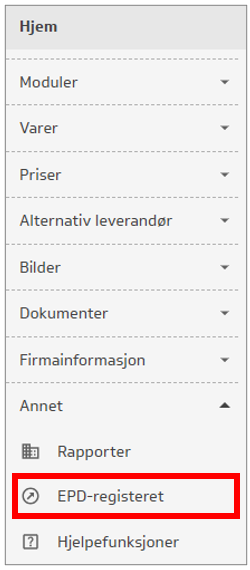How to Calculate the EPD Calculation Factor
To distribute environmental data for products in NOBB, suppliers must:
Create a digital version of their EPDs in the EPD Register.
Register both the EPD Calculation Factor and EPD ID on the products in NOBB Supplier.
You can access the EPD Register in NOBB Supplier under:
Other → EPD Register:

Creation of EPDs in the EPD Register is described within the EPD Register.
On each product in NOBB Supplier, enter the EPD Calculation Factor and EPD ID. This is done under the tab: Properties → Environmental Data. Read more here.
It is also possible to upload an Excel file with these values.
The EPD Calculation Factor is used to calculate the greenhouse gas emissions per pricing unit in NOBB.
Mainly, the declared unit (DU) from the EPD and the pricing unit in NOBB are used to calculate the EPD Calculation Factor. However, for timber products, suppliers may also choose to use the Norwegian Institute of Wood Technology’s guide:
"Greenhouse Gas Results in NOBB – Guide for Conversion of EPD Results" ("Klimagassresultater i NOBB - Veileder til omregning av EPD-resultater").
The EPD Calculation Factor shows the relationship between the declared unit in the EPD and the pricing unit in NOBB.
Below are examples of different combinations of declared units and pricing units.
In other words, products in NOBB should specify the “Number of declared units per pricing unit” in the EPD Calculation Factor field.
Declared Unit | Pricing Unit | Explanation |
|---|---|---|
Square meter (m²) | m² | One-to-one gives a conversion factor of 1.0 |
Square meter (m²) | ROLL | Number of square meters per roll. For example, a 1x12 m roll gives a factor of 12. |
Square meter (m²) | LM (linear meter) | Number of m² per LM |
Square meter (m²) | PCS (STK) | Number of m² per piece |
Cubic meter (m³) | LM | Number of m³ per LM |
Cubic meter (m³) | PCS (STK) | Number of m³ per piece |
Kilogram (kg) | PCS (STK) | Number of kilograms per piece |
Liter (L) | BOX/SPA | Number of liters per item |
Heterogeneous Product:
A heterogeneous product consists of several different components/materials.
Examples include parquet flooring, windows, etc.
To link such a product to an EPD, the pricing unit, conversion factor, and declared unit must together give an accurate picture of the composition on which the EPD is based.
Homogeneous Product:
A homogeneous product consists of a uniform raw material or mixture of raw materials.
Examples include timber, chipboard, and textile blends.
Homogeneous products can have varying density, geometric shape, size, etc.
In such cases, we recommend calculating a factor based on the weight of one pricing unit and the weight of one declared unit.
